THE SECRETS OF FUTURE GHOST FORESTS:
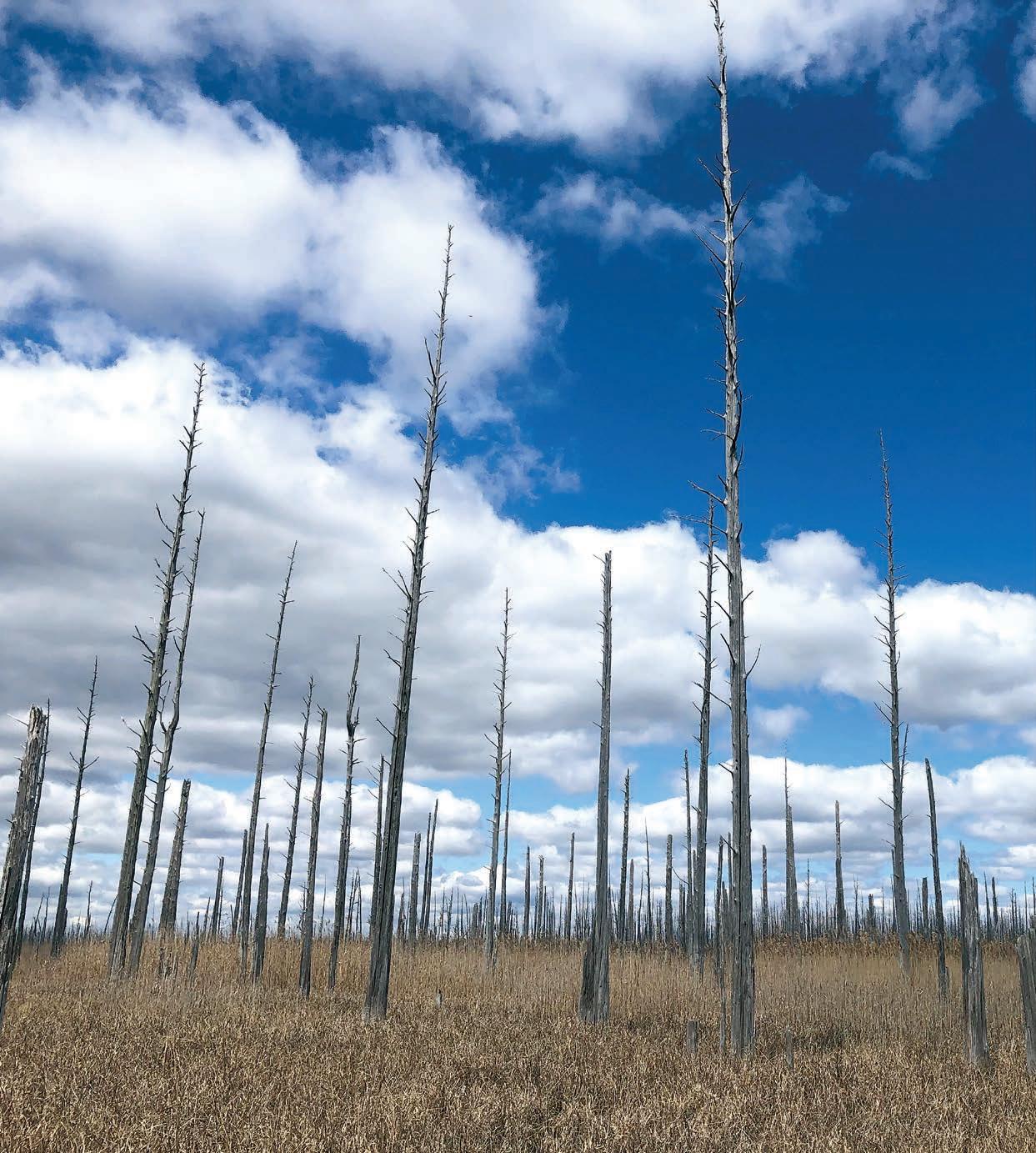
What can loblolly pines in New Jersey tell researchers about sea-level rise?
PAGE 6
Airboats: Getting through Wetlands is a Breeze
PAGE 3
PDE’s Mussel Hatchery Plans
Taking Shape
PAGE 4
THE PARTNERSHIP FOR THE DELAWARE ESTUARY CONNECTING PEOPLE, SCIENCE, AND NATURE FOR A HEALTHY DELAWARE RIVER AND BAY ESTUARY NEWS NEWSLETTER OF THE PARTNERSHIP FOR THE DELAWARE ESTUARY — HOST OF THE DELAWARE ESTUARY PROGRAM IN THIS ISSUE VOLUME 32 NUMBER 1
PDE IN 2022 More Dedicated Than Ever to Our Mission
As the Partnership for the Delaware Estuary (PDE) begins its 26th year of operations, we are more dedicated than ever to our mission and work for clean waters, healthy habitats, and strong communities in the Delaware River and Bay region. Some highlights of what we have in store for 2022 include:
A Freshwater Mussel Hatchery
Planning for building our freshwater mussel hatchery for clean water has stepped into high gear. Working in partnership with Bartram’s Garden in Southwest Philadelphia, where the hatchery will be located, the design process for the hatchery, and adjacent ecosystems education center that the John Bartram Association will operate, is well underway. If all goes as planned, we will break ground to construct these facilities in late 2022. You can read more about this exciting project on page 4.
Infrastructure Funding
This year, and in each of the next four years, the Delaware Estuary Program (DELEP) will receive $915,000 from the Bipartisan Infrastructure Law to support implementation of the Comprehensive Conservation Management Plan for the Delaware Estuary. We are working closely with our DELEP partners to determine how this funding can best support on-the-ground work, research, and capacity building in the Delaware Estuary. The projects funded through this legislation will have an emphasis on addressing climate change and environmental justice and the intersectionality of these critical issues.
Strategic Plan
PDE has just finalized its Strategic Plan for 2022-2026 (https:// delawareestuary.org/about-pde/strategic-plan/). The plan focuses on strengthening our existing programs and expanding our work into new and innovative areas that build on our core values — Collaboration, Science, Innovation, and Engagement.
In 2022, we look forward to keeping you apprised of our progress, sharing the fantastic work our staff and partners are doing to improve water quality in our region, and working together to create new opportunities to engage with communities from across the watershed.
Best wishes,
COMMITEES CONTACT LIST
Meetings conducted by the Delaware Estuary Program’s implementation and advisory committees occur on a regular basis and are open to the public. For meeting dates and times, please contact the individuals listed below:
Estuary Implementation Committee
Kathy Klein
Partnership for the Delaware Estuary
Executive Director (Chair) (800) 445-4935, ext. 102 kklein@DelawareEstuary.org
Monitoring Advisory & Coordination Committee
Elaine Panuccio
Water Restoration
Scientist, Water Quality Assessment
Delaware River Basin Commission (609) 883-9500, ext. 307 elaine.panuccio@drbc.gov
Toxics Advisory Committee
Ron MacGillivray, Ph.D.
Senior Environmental Toxicologist
Delaware River Basin Commission (609) 883-9500, ext. 257 ron.macgillivray@drbc.gov
Science and Technical Advisory Committee
Danielle Kreeger, Ph.D.
Partnership for the Delaware Estuary
Senior Science Director (800) 445-4935, ext. 104 dkreeger@DelawareEstuary.org
Water Quality Advisory Committee
John Yagecic, P.E. Manager, Water Quality Assessment
Delaware River Basin Commission (609) 883-9500, ext. 271 john.yagecic@drbc.nj.gov
ON THE COVER
Dead Atlantic cedars jut out of the ground at Jakes Landing near Cape May, New Jersey. Most trees in the Delaware Estuary region that stand close to salt marshes are at risk of death due to sea-level rise.
KATHY KLEIN, Executive Director, Partnership for the Delaware Estuary
FOLLOW US ON:

VOLUME 32 | ISSUE 1 PARTNERSHIP FOR THE DELAWARE ESTUARY ESTUARY NEWS 2
EXECUTIVE DIRECTOR’S MESSAGE
MAKE GETTING THROUGH WETLANDS A BREEZE
Navigating through wetlands can be tricky. If you’re a wetlands scientist, this is where you spend a lot of your time. Wetlands have many shallow, winding areas that most conventional boats can’t get through easily without damaging the hull or jamming the boat’s propeller.
Walking is no picnic either, and maybe dangerous if you’re carrying heavy equipment. You can slip and fall in the mud or get seriously stuck where the ground is soft, jeopardizing project safety, efficiency, budget, and data quality.
Scientist Leeron Tagger, owner of Northland Airboats, LLC and Principal Wetland Ecologist at Kleinfelder, has a solution. Since 2013, the East Brunswick, New Jersey, resident has provided transportation and field solutions for all kinds of projects occurring in marshlands and tidal waters, including wetland protection, restoration and research, marine/utility construction support, sediment sampling services, and environmental investigations with his airboat company. Tagger has helped organizations like Partnership for the Delaware Estuary (PDE) and NY/NJ Baykeeper access their project sites and complete fieldwork efficiently and safely.
“Working with the team at PDE has been a treasure,” Tagger said. “The knowledge base of PDE’s staff and their commitment to the health of the Estuary is inspirational and contagious.”
People typically associate airboats with the swamps and bayous of Louisiana and the rest of the Gulf Coast. Tagger has found that these boats work just as well getting through the creeks and marshlands of the Delaware Estuary.
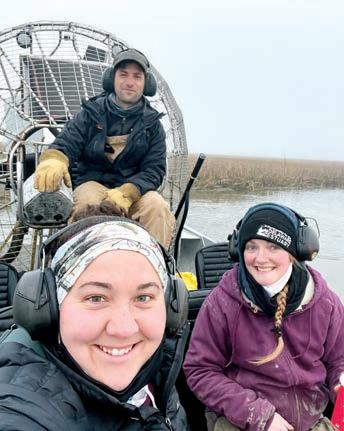
Tagger has been a wetland ecologist-environmental scientist for more than 16 years and had his first airboat experience a little more than 12 years ago while working as an EPA subcontractor on a large emergency response project. More than a million gallons of heavy crude oil and tar

VOLUME 32 | ISSUE 1 PARTNERSHIP FOR THE DELAWARE ESTUARY ESTUARY NEWS 3
TIDINGS
Top: Ellie Rothermel, PDE’s Science Technical Analyst, left, and LeeAnn Haaf, PDE’s Wetlands Coordinator aquire data in a New Jersey wetland. They arrived at their site via Leeron Tagger’s airboat. Photo courtesy of Leeron Tagger. Bottom: Leeron Tagger, back, an environmental scientist and owner of Northland Airboats, LLC, often aids other scientific researchers such as Haaf, right, and Emily Pirl of the Barnegat Bay Partnership, left, reach wetland areas. Photo by Emily Pirl.
continued on page 11 AIRBOATS
PDE’s Mussel Hatchery Plans Taking Shape
CONSTRUCTION COULD START LATER THIS YEAR ON THE FIRST FRESHWATER MUSSEL HATCHERY IN THE UNITED STATES THAT’S BUILT FOR THE IMPROVEMENT OF WATER QUALITY. ONCE THE HATCHERY IS UP AND RUNNING, SCIENTISTS FROM PARTNERSHIP FOR THE DELAWARE ESTUARY (PDE) AIM TO PRODUCE 500,000 FRESHWATER MUSSELS PER YEAR.
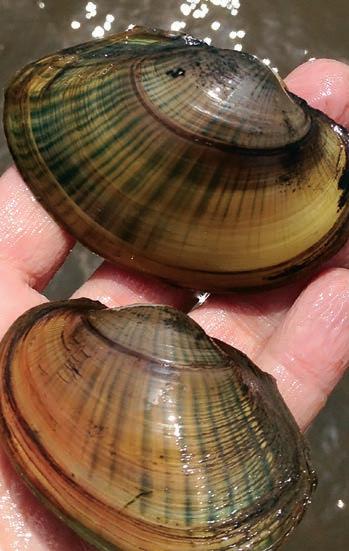
“Freshwater mussels are one of the most imperiled and depleted groups of animals in North America, and the loss of robust beds of mussels that help keep the water clean hampers our efforts to control pollution,” said PDE’s Science Director Danielle Kreeger, Ph.D. “The hatchery will supply the animals needed to rebuild natural beds of mussels in our streams, rivers, and lakes — to put nature back to work, especially in urban waters that are impaired for water quality.”
A lot has happened behind the scenes since early 2019 when PDE announced its plans to build the hatchery at Bartram’s Garden in Southwest Philadelphia, in partnership with the John Bartram Association. The announcement came after PDE signed a nearly $8 million funding agreement with the Pennsylvania Infrastructure Investment Authority (PENNVEST). PDE’s goal to produce 500,000 mussels per year is to increase populations of native mussel species, mainly to help filter and purify water in the Delaware and Susquehanna rivers.
After the 2019 announcement, PDE and Bartram’s Garden got to work laying the groundwork — making sure the proposed building site is viable for development, and talking with engineers about project management and design.
Momentum on the project slowed during the height of the COVID pandemic, but PDE continued to work with construction managers at Urban Engineers and the design firm WRT on vetting building designs and working on lease agreements with the City of Philadelphia. Bartram’s Garden is coordinating its own plans to build an ecosystems education center alongside the hatchery building.
VOLUME 32 | ISSUE 1 PARTNERSHIP FOR THE DELAWARE ESTUARY ESTUARY NEWS 4 UPDATES
Freshwater mussels are one of nature’s best water filters. The new hatchery will supply mussels that will go back into streams, rivers, and lakes to help clean them naturally.
“In addition to the impact on our watershed, the mussel hatchery is a wonderful opportunity to inspire the thousands of students who visit Bartram’s Garden each year,” said Bartram’s Garden Executive Director Maitreyi Roy. “Connecting our local youth with the daily work of scientific research and watershed health will allow them to imagine their own connection to the river and its future.”
The hatchery is an essential feature in furthering PDE’s Mussels for Clean Water Initiative (MuCWI). This initiative is part of the multifaceted Freshwater Mussel Recovery Program (FMRP), which aims to restore native species of freshwater mussels to streams, rivers, and lakes in the upper mid-Atlantic region, particularly in the Delaware River Basin. The main goal of MuCWI is to promote cleaner water and healthier aquatic ecosystems via the propagation and restoration of freshwater mussels created from a central hatchery into waters where they have been lost, as well as in man-made systems such as stormwater ponds.
“We are excited to collaborate with PDE to establish the freshwater mussel hatchery and a new ecosystems education center at Bartram’s Garden,” Roy said. “Our partnership to implement the goals of the Mussels for Clean Water Initiative will in turn support our southwest Philadelphia community’s own priorities for environmental justice and STEM education.”
Once PDE and Bartram’s Garden complete the design and permitting for the two buildings, construction will get underway. Groundbreaking could take place before the end of 2022.
“We are thrilled to be partnering with Bartram’s Garden and the City of Philadelphia to have the hatchery located at this historic site. The endless opportunities to engage with the local community and other partners from across the region is very exciting.”
KATHY KLEIN, PDE Executive Director
NEXT STEPS
The hatchery building will be environmentally compliant and equipped with everything needed to achieve PDE’s hatchery’s research and production goals. A second floor will contain offices, laboratories, and a greenhouse for growing algae. In addition to the hatchery, PDE plans to have satellite mussel rearing locations with additional partners throughout the Delaware River Watershed.
“To know we are building something that’s a first of its kind in the United States is very exciting,” said PDE’s Executive Director Kathy Klein. “We are thrilled to be partnering with Bartram’s Garden and the City of Philadelphia to have the hatchery located at this historic site. The endless opportunities to engage with the local community and other partners from across the region is very exciting.”
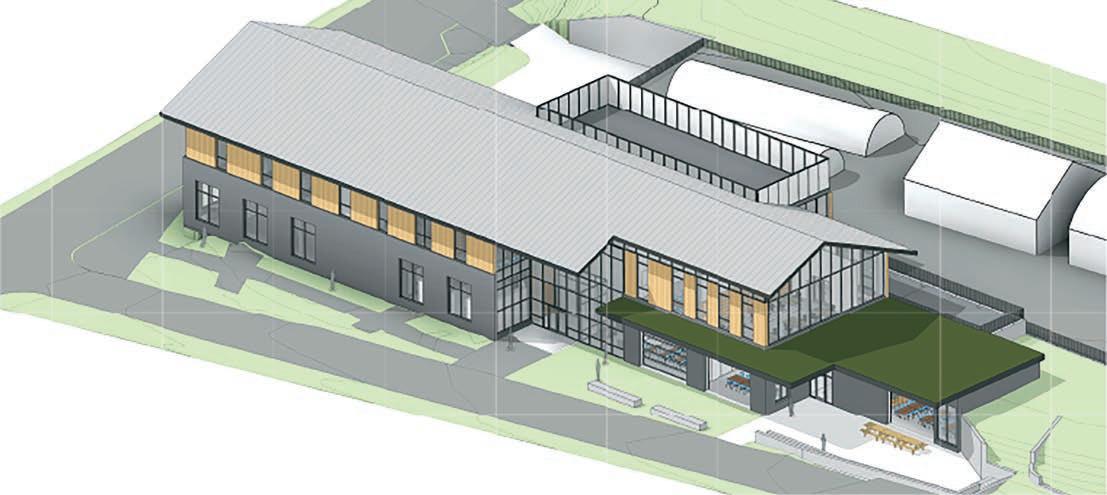
HEALTHY HABITATS • GOAL H3.3
VOLUME 32 | ISSUE 1 ESTUARY NEWS 5
PARTNERSHIP FOR THE DELAWARE ESTUARY
This schematic drawing is one design that PDE and Bartram’s Garden are considering for new facilities in Southwest Philadelphia. The mussel hatchery is the larger wing to the left and the Bartram’s educational center is the adjacent building on the right. Construction could begin in 2022.
THE SECRETS OF FUTURE GHOST FORESTS
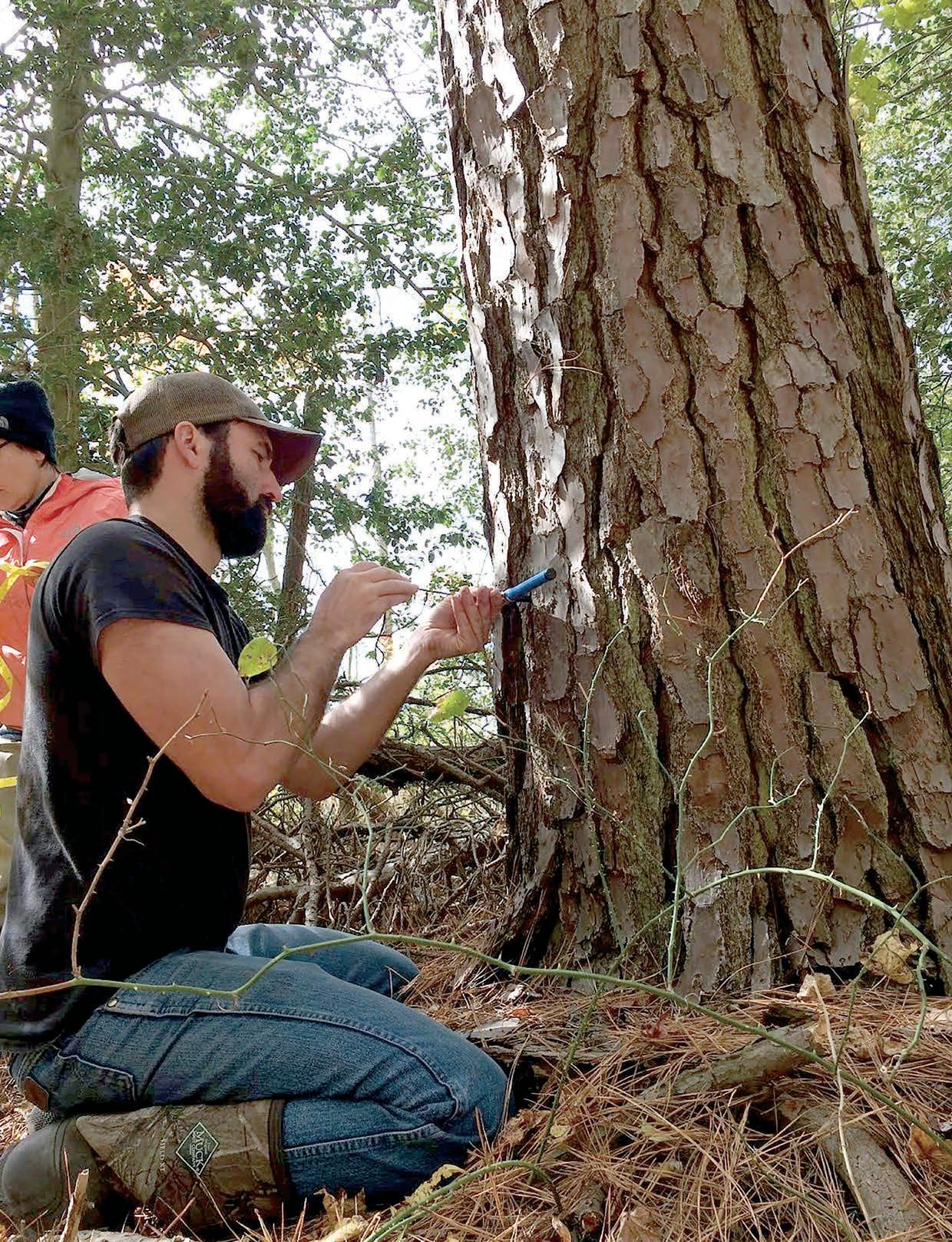
VOLUME 32 | ISSUE 1 PARTNERSHIP FOR THE DELAWARE ESTUARY ESTUARY NEWS 6 MAKING WAVES
Volunteer field technician Chris Daugherty extracts a tree core from a loblolly pine using an increment borer.
Researching the effects of coastal flooding and climate change on loblolly pines at Jakes Landing, New Jersey
By LeeAnn Haaf, PDE’s Wetlands Coordinator
Jakes Landing is a centuries-old access point to Dennis Creek in Cape May, New Jersey, where the forest landscape abruptly drops into a tidal saltwater marsh. Close to the marsh, row after row of dead Atlantic white cedars jut out of the ground like spikes. Just beyond those are swaths of statuesque loblolly pines. The forest is healthy now, but these trees are in danger. Most trees in the Delaware Estuary region that stand close to salt marshes are at risk of death due to sea-level rise.
Sea-level rise and climate change are pushing coastal flooding farther into low-lying forests and slowly killing nearby trees, causing what often are called “ghost forests.” Eventually, the swaths of healthy loblolly pines will become inundated with water from flooded marshes and likely suffer the same fate as their neighbors, the Atlantic cedars. However, careful research and studies of trees while they’re still healthy can help managers understand how frequent salt marsh flooding might affect them before they die and where to focus their efforts to prevent more trees from dying.
Loblolly pine itself is not an imperiled species. It’s one of the more abundant pines in the eastern U.S. (mainly towards
the South). Over the last 100 years, loblollies at Jakes Landing have grown under various conditions — droughts, blizzards, heat waves, hurricanes, and coastal floods. Under these stressful conditions, the pines didn’t grow as much as they might under gentler ones. As trees grow new wood each year, patterns about their health and conditions emerge within the trees’ rings. With sea levels rising, increased flood frequency in the forests might result in thinner and thinner rings, which could foreshadow tree death.
READING THE RINGS
By collecting tree ring samples, researchers uncover how weather, saltwater, and climate are affecting trees that are exceptionally close to marshes at Dennis Creek. Wetlands researchers from Partnership for the Delaware Estuary (PDE) have carefully removed about 50 tree core samples from the pines at Jakes Landing to observe patterns in annual tree growth. The core samples are about the size and shape of a narrow drinking straw. Extracting them doesn’t harm the trees, but the cores help researchers study patterns in tree growth relative to climate and tidal water levels changes over time.
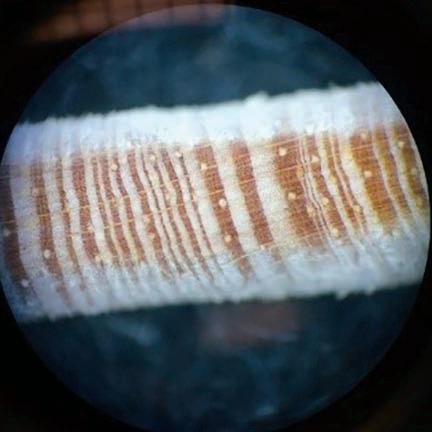
After sanding, measuring, and analyzing core samples, PDE researchers found that loblolly pines at Jakes Landing grew best during warm winters but often grew less when tidal water levels in the previous autumn were high. New Jersey is the farthest north in the United States where loblolly pine grows. Winters in the Delaware Estuary region are chillier than loblollies prefer, but over the past years, winters in the Delaware Estuary have gotten warmer due to climate change. Increased salt marsh flooding, however, could counteract the benefit of warmer mid-Atlantic winters and threaten the health of low-lying loblolly pines.
PDE’s research will help foresters and land managers anticipate how well these trees will grow in the future in different areas experiencing more flooding. Perhaps their findings can provide details that help factor climate change and sea level rise into research management plans.
VOLUME 32 | ISSUE 1 PARTNERSHIP FOR THE DELAWARE ESTUARY ESTUARY NEWS 7
HEALTHY
HABITATS • GOAL H2
LeeAnn Haaf is a Ph.D. candidate at Drexel University, studying the effects of coastal flooding on low-lying tree growth in the mid-Atlantic region of the United States.
MORE INFORMATION: For more technical information about this and other sites, see our publication here: https://www.mdpi.com/1999-4907/12/10/1351
A sanded tree core image enlarged under microscope. Rings tell researchers a tree’s age and the conditions under which the tree grew from year to year. When conditions are good, trees grow thick rings. Rings are thinner when growing conditions are less optimal.
Volunteer this Spring for the 12th Annual Schuylkill Scrub
By Meghan Rogalus, Schuylkill Action Network Manager
You’re invited to join in the 12th annual Schuylkill Scrub taking place from now through May 31. Local cleanup organizers in the Schuylkill River Watershed are looking for people of all ages to participate in local cleanups to help keep the Schuylkill River Watershed and Pennsylvania beautiful.
Litter on our landscape washes into our waterways from sidewalks and streets via storm drains. In addition to being an eyesore, the trash can harm wildlife. This trash can also foul water utility intake systems and increase treatment costs.
The Schuylkill Action Network (SAN) is a collaborative network of nonprofits, government agencies, water utilities, and academia working together to protect the Schuylkill River Watershed. The Schuylkill River Watershed is a source of drinking water for nearly 2 million people. The Schuylkill Scrub fits with the SAN’s newly released five-year action plan, which calls for removing 5 million pounds of trash from the watershed through 2025. You can do your part to make this goal a reality. To get involved download the CleanSweep app or visit http://www.schuylkillscrub.org/
IF YOU GO
WHEN
March 1 to May 31
WHERE
Individual cleanups will be held throughout the Schuylkill River Watershed. For locations and information on how to get involved, visit http://www. schuylkillscrub.org/ or download the CleanSweep app.
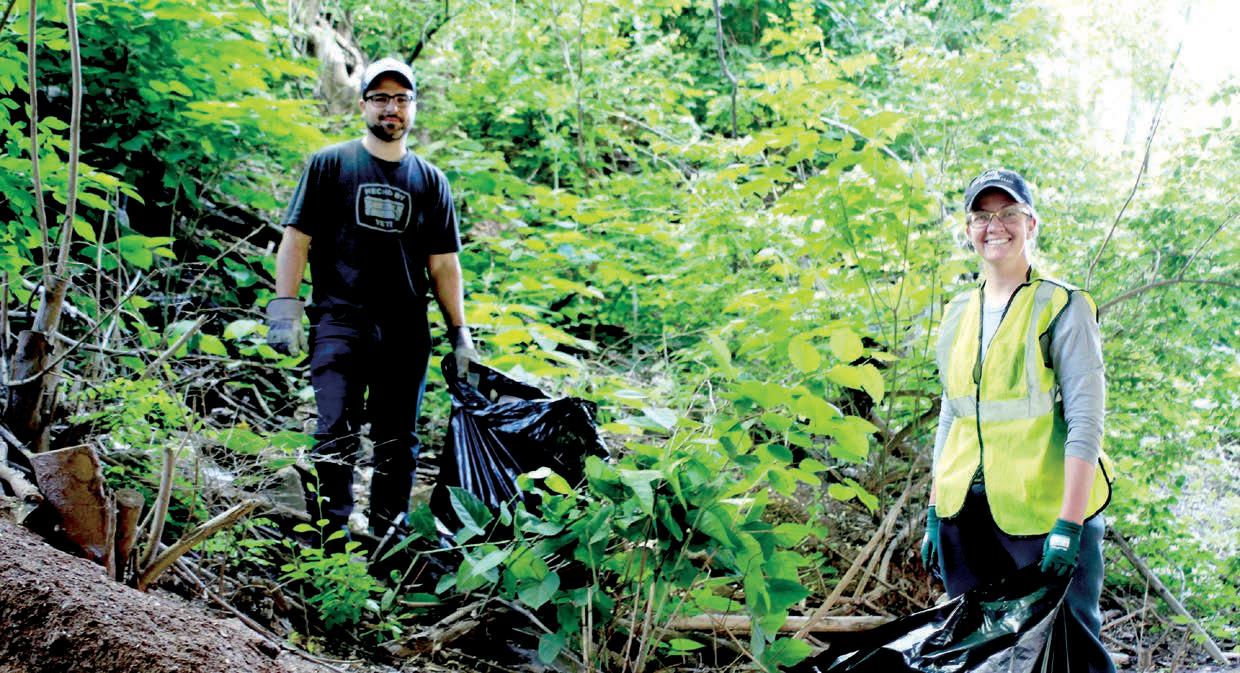
VOLUME 32 | ISSUE 1 PARTNERSHIP FOR THE DELAWARE ESTUARY ESTUARY NEWS 8 ESTUARY EXCURSIONS
STRONG COMMUNITIES • GOAL C1.3 // C2
Volunteers help out during the annual Schuylkill Scrub, which runs through May 31 throughout the Schuylkill River Watershed.
Christina River Watershed Cleanup Celebrates 30 Years of Volunteers

How much trash can 24,000 volunteers clean out of the Christina River Watershed over 30 years? Answer is, a lot of trash indeed.
Since 1992, volunteers for the Christina River Watershed Cleanup have removed a total of 450 tons from northern Delaware waterways. This year is the event’s 30th anniversary, and coordinators intend to add to that total.
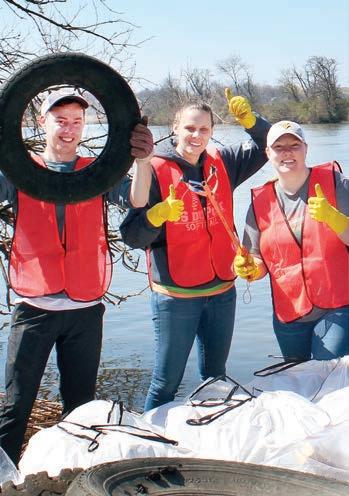
This year’s cleanup will take place on Saturday, April 2 cleanup. There will be cleanup sites all over the Christina River Watershed in New Castle County, Delaware, including the Brandywine, White Clay, and Red Clay creeks, and the Christina River. Partnership for the Delaware Estuary will be the host of one of the cleanup sites on the Christina River in downtown Wilmington.
Shirley Posey, Coordinator of the Christina River Watershed Cleanup, said about 700 people volunteer per year who pick up between 15 and17 tons of trash. Before the COVID-19 pandemic, the volume of collected trash had started going down. Since the upcoming event will be the first in-person cleanup in two years, Posey isn’t sure how much trash collection to expect.
Volunteers occasionally find unusual items such as toys or unique pieces of glass during cleanups, but plastic drinking straws, plastic bags, paper cups, fast food wrappers and tires — yes tires — make up the bulk of the trash collected.
“People still just throw stuff out the window,” Posey said about litterbug behavior. “It’s very upsetting, especially when you’re in a car behind one of these other cars and you see someone do something like that.”

But seeing people turn out each year for the cleanups is uplifting. Posey gets calls from people all year long who look forward to volunteering. Strangers come together and get to know one another and families show up with children who learn valuable lessons from the experience.
“It’s very rewarding, just to see the people — the people are so happy, they love doing it,” Posey said.



Posey thanked the cleanup’s various sponsors whose support pays for bags, gloves, and other supplies.
“We’ve certainly done our share and are very proud of what we’ve done,” Posey said.
For more information about the cleanup, or to sign up as a volunteer, visit www.christinarivercleanup.org
IF YOU GO


WHEN Saturday, April 2 9 a.m. to Noon


WHERE


























Sites throughout the Christina River Watershed in New Castle County, Delaware. Sign up to volunteer by going to: www.
christinarivercleanup.org















STRONG COMMUNITIES • GOAL C1.3 // C2
VOLUME 32 | ISSUE 1 PARTNERSHIP FOR THE DELAWARE ESTUARY ESTUARY NEWS 9 GET INVOLVED
Volunteers help out during the 2019 Christina River Watershed Cleanup. The Cleanup returns in person this year and volunteers are needed.
FUNDING WAS FOCUS OF THE 5TH ANNUAL RASCL SUMMIT
By Jana Savini, PDE’s Coastal Collaboration Assistant Coordinator
The Delaware Resilient and Sustainable Communities League (RASCL) convened on December 7-8, 2021 for the 5th annual RASCL Summit. This was the second time that organizers held the Summit virtually.
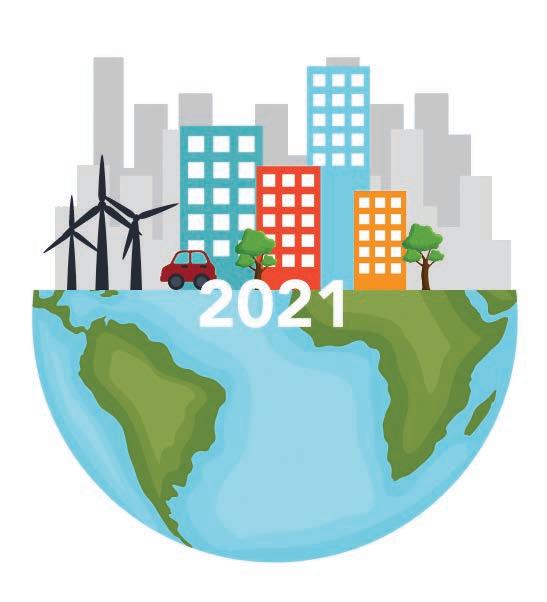
More than 200 attendees, representing non-profits, local governments, state agencies, private consultants, and community groups participated in this year’s Summit, themed “Go for the Green: Funding and Designing Resilient Infrastructure.”
Three panel sessions, respectively on grant funders, innovative funding, and local stories, gave presenters and attendees the opportunity to share information and ask questions. The grant funders session featured panelists from various agencies and organizations that award and administer grants to communities. Speaking from a funder’s perspective, this session provided insights into the qualities that turn a grant proposal into a grant award.
The panel on innovative funding promoted various financing models and innovative ways in which communities can generate money to implement resiliency and sustainability projects. Topics included environmental impact bonds, stormwater utilities, and legislative funds that do not require grant applications.
The local stories panel featured projects from across Delaware that emphasize resiliency, sustainability, and the use of nature-based infrastructure. Panelists spoke about the funding they received for their projects and lessons learned that could be of value throughout the state.
Many thanks to all of the sponsors, speakers, moderators, and planning committee for making this year’s RASCL Summit a success! Presentations and panel recordings are available at www.derascl.org/ summit
VOLUME 32 | ISSUE 1 PARTNERSHIP FOR THE DELAWARE ESTUARY ESTUARY NEWS 10
STRONG COMMUNITIES • GOAL C6 ESTUARY BASICS
THE PANEL ON INNOVATIVE FUNDING PROMOTED VARIOUS FINANCING MODELS AND INNOVATIVE WAYS IN WHICH COMMUNITIES CAN GENERATE MONEY TO IMPLEMENT RESILIENCY AND SUSTAINABILITY PROJECTS.
spilled into Talmadge Creek, its floodplain, and eventually the Kalamazoo River in Michigan. An airboat got him between the water and land. “There were almost no restrictions with access,” Tagger said. “It was the airboats that provided the means of transportation to perform so many important job duties on that emergency response from oil cleanup and transport of tools, spill pads, dredging equipment, and post-construction surveys to finding the extent of contamination in the most remote locations. They did it all.”
Inspired by their versatility, Tagger purchased a 21-foot commercial grade airboat of his own in Louisiana and drove it 1,300 miles back to New Jersey. Within a few months, he started working with government agencies, non-profits, private firms, and tourism groups. Tagger is a United States Coast Guard-licensed captain for the boat. He uses the airboat all over Delaware, New Jersey, Pennsylvania, Maryland, and Virginia. Countless times, airboats have made it possible to collect accurate data efficiently and safely.
An airboat’s construction is key to its ability to skim through challenging terrain. The main body is flat on the bottom and has an 80-inch carbon fiber propeller mounted above the stern attached to a 454-Chevrolet big block motor to thrust the boat forward. Tagger’s airboat can carry passengers across shallow and deep water, marshes, mudflats, dense vegetation, logjams, and across ice and snow.
“Working with Leeron is fantastic,” said LeeAnn Haaf, PDE’s Wetlands Coordinator. “The airboat gets us precisely where we need to go in intertidal marshes that are not necessarily accessible by conventional boat. This means we can more easily bring all the heavy equipment we need to each site without factoring in how much time and strain it will take to lug 50-plus pounds of stuff through soft terrain. Honestly, with excessive heat in the summer and the odds of injury from carrying equipment, using an airboat is the safest option.”
WILMINGTON EARTH DAY CELEBRATION

Saturday, April 23
1:30 TO 4:30 P.M. MARKET STREET
WILMINGTON, DELAWARE
Take the family out and celebrate Earth Day in downtown Wilmington, Delaware. This year’s Wilmington Earth Day Celebration is back with a live, open-street event on Market Street. Enjoy crafts, booths with various environmental education, native plants, and downtown shopping and eateries. For more information, go to www.delawareestuary.org/earthandarbor
SAVE THE DATE!
EXPERIENCE THE ESTUARY CELEBRATION 2022

Thursday, October 13
VIE BY CESCAPHE, PHILADELPHIA
The date is set! Join Partnership for the Delaware Estuary and hundreds of its supporters in Philadelphia for the annual Experience the Estuary Celebration. Enjoy lively company, cocktails, great food, and the famous 90-minute raw oyster bar. Stay tuned for more information at https://delawareestuary.org/news-andevents/experience-estuary/
VOLUME 32 | ISSUE 1 PARTNERSHIP FOR THE DELAWARE ESTUARY ESTUARY NEWS 11 EVENTS
page 3
HEALTHY HABITATS • GOAL H1 // H1.2 // H2.2 Airboats Make Getting Through Wetlands a Breeze continued from
William Parry of CSX, Lance Rasnake of Wood, and past PDE board member Juni Alam attended the 2021 Experience the Estuary Celebration event.
110 South Poplar Street, Suite 202
Wilmington, DE 19801
ADDRESS SERVICE REQUESTED
GET ESTUARY NEWS ONLINE AND SAVE PAPER! IT’S EASY!
E-mail KOConnell@delawareestuary.org and say you want to receive only electronic copies. Provide your name
Confirm your email address
THE PARTNERSHIP FOR THE DELAWARE ESTUARY
CONNECTING PEOPLE, SCIENCE, AND NATURE FOR A HEALTHY DELAWARE RIVER AND BAY
The Partnership for the Delaware Estuary, Inc. (PDE), is a private, nonprofit organization established in 1996. PDE is the host of the Delaware Estuary Program and leads science-based and collaborative efforts to improve the tidal Delaware River and Bay, which spans Delaware, New Jersey, and Pennsylvania. To find out how you can become one of our partners, call PDE at (800) 445-4935 or visit our website at www.DelawareEstuary.org.
Partnership for the Delaware Estuary, Inc.
Kathy Klein (800) 445-4935
kklein@DelawareEstuary.org
Environmental Protection Agency
Irene Purdy, EPA Region II (212) 637-3794
purdy.irene@epa.gov
Megan Mackey, EPA Region III (215) 814-5534
mackey.megan@epa.gov
Pennsylvania Kristina Peakcock-Jones, P.E.
Department of Environmental Protection (717) 772-5671
kpeacockjo@pa.gov
Delaware Kimberly Cole Department of Natural Resources and Environmental Control (302) 739-9283
kimberly.cole@delaware.gov
New Jersey
Lynette Lurig Department of Environmental Protection (609) 633-1314
lynette.lurig@dep.nj.gov
Delaware River Basin Commission
Chad Pindar (609) 883-9500 ext 268
chad.pindar@drbc.gov
Estuary News encourages reprinting of its articles in other publications. Estuary News is produced four times annually by the Partnership for the Delaware Estuary, Inc. (PDE), under an assistance agreement (CE-99398516-0) with the U.S. Environmental Protection Agency (EPA). The purpose of this newsletter is to provide an open, informative dialogue on issues related to PDE. The viewpoints expressed here do not necessarily represent the views of PDE or EPA, nor does mention of names, commercial products or causes constitute endorsement or recommendation for use. For information about the PDE, call 1-800-445-4935.
Philadelphia Water Department Kelly Anderson (215) 685-6245
kelly.anderson@phila.gov
Editor Kate Layton (800) 445-4935
klayton@DelawareEstuary.org
Unless otherwise noted, all photos are property of the Partnership for the Delaware Estuary.
US POSTAGE Non-Profit Org PAID Wilmington, DE Permit #1885
VOLUME 32 | ISSUE 1 PARTNERSHIP FOR THE DELAWARE ESTUARY ESTUARY NEWS 12
PRINTED ON RECYCLED PAPER





















